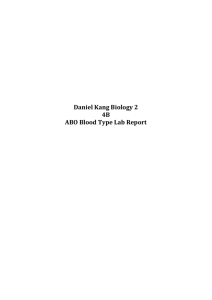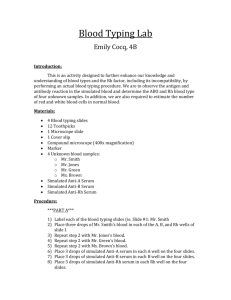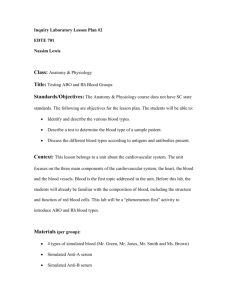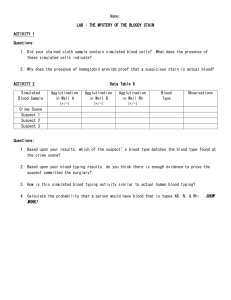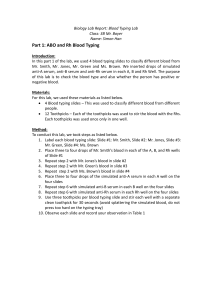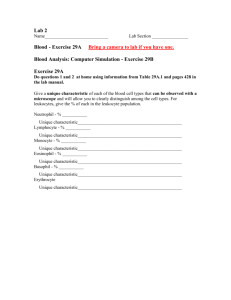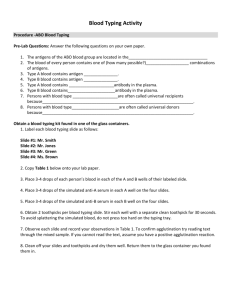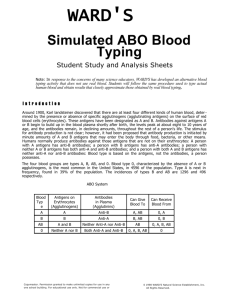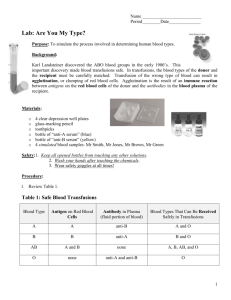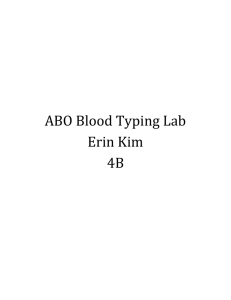double sapce
advertisement
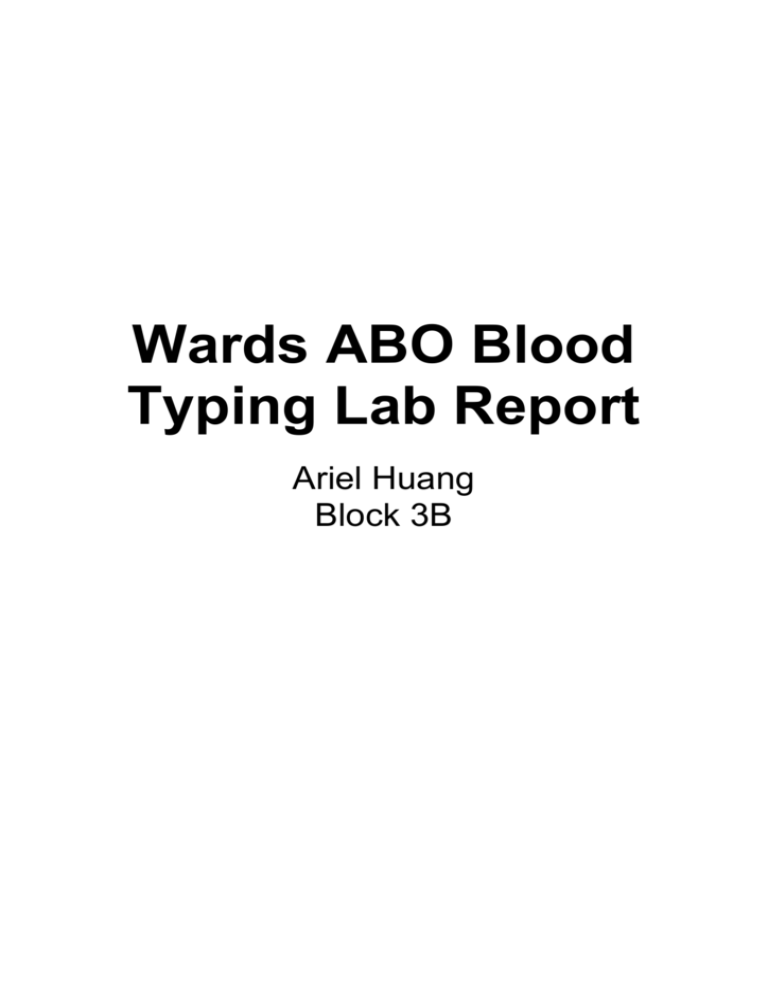
Wards ABO Blood Typing Lab Report Ariel Huang Block 3B Introduction: The objective of this lab is to determine the blood types of each person and see how the blood reacts to different serums—Anti-A, Anti-B, and Anti-Rh. The way in which we’ll verify the blood types of each person is by looking at the agglutination that occurs in our experiment. Apart from understanding the connection between agglutination and discovering blood types, we also learn about the importance of blood typing and how crucial getting the right blood types of each person in a hospital is. Unless a person has type AB blood— universal donor—they would die if they received a blood transfusion from someone who has a different blood type than them. The agglutination that occurs in our experiment will not only help us determine the blood type of that person, but also helps us understand the concept behind blood crossing and the potential dangers of accidental blood transfusions. HypothesisSince we’re trying to determine the blood types of each person, my guess is that there will be one of each blood type—A, B, O, and AB blood and agglutination won’t occur in type O blood since it’s a universal donor and doesn’t have any antigens. PART A: ABO and Rh BLOOD TYPING Materials: Materials needed per group 4 Blood typing slides 12 Toothpicks Shared Materials 4 Unknown blood samples: o Mr. Smith o Mr. Jones o Mr. Green o Ms. Brown Simulated Anti-A Serum Simulated Anti-B Serum Simulated Anti-Rh Serum Procedure: 1. Label each blood typing slide on a blank piece of paper with the following: Slide #1: Mr. Smith Slide #2: Mr. Jones Slide #3: Mr. Green Slide #4: Ms. Brown 2. Place three to four drops of Mr. Smith’s blood in each of the A, B, and Rh wells of Slide #1 3. Place three to four drops of Mr. Jones’s blood in each of the A, B, and Rh wells of Slide #2 4. Place three to four drops of Mr. Green’s blood in each of the A, B, and Rh wells of Slide #3 5. Place three to four drops of Ms. Brown’s blood in each of the A, B, and Rh wells of Slide #4 6. Place three to four drops of simulated anti-B serum in each B well on the four slides 7. Place three to four drops of the simulated anti-Rh serum in each Rh well on the four slides ***Make sure all the droplets are about the same size. Applies to procedures 2-7 8. Obtain three toothpicks per blood typing slide. Stir each well with a separate clean toothpick for about 30 seconds. To avoid splattering the simulated blood, do not press too hard on the typing tray 9. Observe each slide and record observations in Table. 10. Wash toothpicks and slide trays after use Steps 2-5 Step 8 Steps 6 & Step 9 PART B: Blood Cell Count Materials: Materials Needed per Group 1 Microscope Slide 1 Coverslip WARD’S Simulated Blood [Mr. Jones] Compound Microscope Procedure: 1. Thoroughly shake the vial of simulated blood that belongs to Mr. Jones 2. Add a small drop of Mr. Jones’s simulated blood to the microscope slide 3. Lower the coverslip onto the slide slowly to avoid trapping air bubbles 4. Absorb excess sample from coverslip with a paper tissue 5. On low power objective, observe the slide. Find an area with the best distribution of cells 6. Switch to 400X magnification and observe slide again 7. Count number of simulated red blood cells and record data in Table 2 8. Count number of simulated white blood cells and record data in Table 2 9. Repeat counting procedure with two other fields of view. Record data in Table 2 10. Calculate average red blood cell count and white blood cell count and record data in Table 2 11. Multiply the average number of red and white blood cells by the dilution factor to determine the number of red and white blood cells per cubic millimetre. Record value in Table 2 12. Wash coverslip and slide Data: Table 1 Anti-A Serum Anti-B Serum Slide #1 Mr. Smith Slide #2 Mr. Jones Very clumpy Normal Normal Slide #3 Mr. Green Slide #4 Ms. Brown Table 2 Blood Cell Type White (Blue) Blood Type Normal B- Viscous, clumpy Normal, solution thicker than others Sort of clumpy Viscous, clumpy AB+ Normal Normal Normal O- Cell Count 1 Red (Red) Anti-Rh Serum Very clumpy 2 3 281 244 259 6 5 7 Total # of Cells Average # of Cells Or Total/3 Dilution Factor 784 261.3 18 6 150,00 0 5,000 300 250 200 White (Blue) 150 Red (Red) 100 50 0 Average # of Cells 900 800 700 600 500 400 300 200 100 Conclusion: 0 White (Blue Red (Red) Total # of Cells A+ Total # Blood Cells per mm3 or Avg. # of Cells x Dilution Factor 39,195,000 30,000 Through our experiment, we’ve concluded that Mr. Jones has type B- blood, Mr. Smith has type A+ blood, Mr. Green has type AB+ blood, and Ms. Brown has type O- blood. From this experiment, we’ve determined that since Ms. Brown has type O- blood, every other blood type can safely receive her donated blood, but she can only receive type O blood from other donors. Apart from figuring out the blood types of each ‘person’, we also applied our knowledge or recessive and dominant traits in the punnett squares to these blood types, for example, we can conclude that a man with a blood type of O could not be the father of a child with type AB blood due to the fact that type AB blood’s genotype is (IᴬIᴮ) and O blood’s genotype is ( i i ) and is recessive. If parent 1 has type A blood (Iᴬi) and parent 2 has type B blood (Iᴮi), there is a 25% chance that their child will have type O blood, 25% chance of type A blood (Iᴬi), 25% chance of type B blood (Iᴮi), and 25 % chance of having type AB blood (IᴬIᴮ). Through this lab, we can learn the importance of medical history in a hospital as a person could die if they receive a transfusion from a donor whose blood type is different than theirs. Evaluation: Overall, I think we did a fairly good job on this lab, but one thing we can improve on is efficiency. I think if we were more efficient with our time, we could’ve done part B of the experiment—the blood cell count—twice and compare our results. We did well on following the procedure and completing the experiment. Another thing that I think I can improve on for my next lab is recording data and observations because I think I could’ve added side notes and record more observations down to support my lab.

